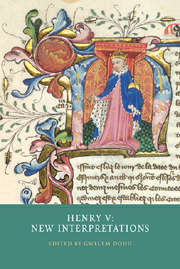Book contents
- Frontmatter
- Dedication
- Contents
- Preface and Acknowledgements
- List of Contributors
- Abbreviations
- Introduction
- 1 The Making of a Prince: The Finances of ‘the young lord Henry’, 1386–1400
- 2 Henry V's Establishment: Service, Loyalty and Reward in 1413
- 3 Henry V, Lancastrian Kingship and the Far North of England
- 4 Henry V's Suppression of the Oldcastle Revolt
- 5 Religion, Court Culture and Propaganda: The Chapel Royal in the Reign of Henry V
- 6 ‘Par le special commandement du roy’. Jewels and Plate Pledged for the Agincourt Expedition
- 7 Henry V and the Cheshire Tax Revolt of 1416
- 8 Henry V and the English Taxpayer
- 9 Henry V, Flower of Chivalry
- 10 War, Government and Commerce: The Towns of Lancastrian France under Henry V's Rule, 1417–22
- 11 Writing History in the Eighteenth Century: Thomas Goodwin's The History of the Reign of Henry the Fifth (1704)
- Index
- York Medieval Press: Publications
9 - Henry V, Flower of Chivalry
Published online by Cambridge University Press: 05 July 2013
- Frontmatter
- Dedication
- Contents
- Preface and Acknowledgements
- List of Contributors
- Abbreviations
- Introduction
- 1 The Making of a Prince: The Finances of ‘the young lord Henry’, 1386–1400
- 2 Henry V's Establishment: Service, Loyalty and Reward in 1413
- 3 Henry V, Lancastrian Kingship and the Far North of England
- 4 Henry V's Suppression of the Oldcastle Revolt
- 5 Religion, Court Culture and Propaganda: The Chapel Royal in the Reign of Henry V
- 6 ‘Par le special commandement du roy’. Jewels and Plate Pledged for the Agincourt Expedition
- 7 Henry V and the Cheshire Tax Revolt of 1416
- 8 Henry V and the English Taxpayer
- 9 Henry V, Flower of Chivalry
- 10 War, Government and Commerce: The Towns of Lancastrian France under Henry V's Rule, 1417–22
- 11 Writing History in the Eighteenth Century: Thomas Goodwin's The History of the Reign of Henry the Fifth (1704)
- Index
- York Medieval Press: Publications
Summary
Introduction
On 6 November 1422, the coffin of Henry V was carried to a funeral carriage by eight chamber knights, with four earls holding each of the corners of a cloth of gold on top of it, and four knights supporting a canopy above the coffin. Two of the horses that drew the carriage were decorated with the arms of England, and the other three horses wore the arms of St Edmund, St Edward and St George. As the procession moved towards Westminster, the coffin was followed by knights and pages on horseback, carrying the king's helmet and the shields of England and France. After the Requiem Mass at Westminster Abbey the following day, three knights rode their horses up to the high altar where they removed their armour, symbolically representing Henry V's laying down of his knightly responsibilities in death.
As these elaborate rituals demonstrated, Henry V was celebrated not merely as a monarch but also as a great knight. Kingship and chivalry were not separate constructs in late medieval didactic works, chronicles and biographies which praised ideal qualities like loyalty, largesse, honour and above all prudence that were essential for both kings and knights. Both were founded upon the cardinal virtues of justice, temperance, prudence and fortitude that were so important not just for kings and knights but for all Christians. Contemporary authors constantly emphasized the obligations of a king to fight, but also of a knight to be wise and prudent, especially when serving as a lord or a military commander.
- Type
- Chapter
- Information
- Henry VNew Interpretations, pp. 217 - 248Publisher: Boydell & BrewerPrint publication year: 2013



